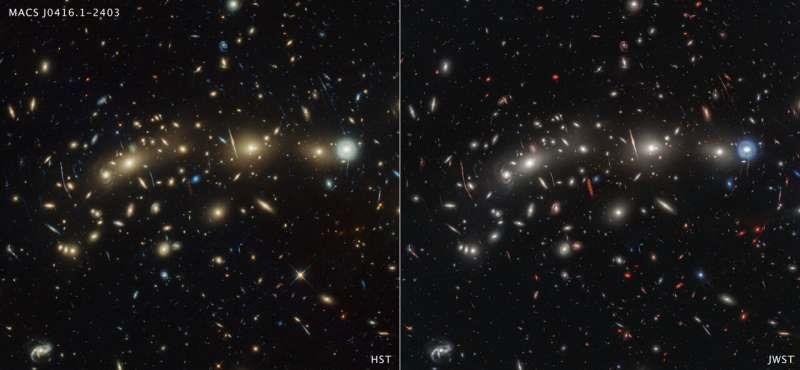Webb, Hubble Join Hands To Create Most Colourful View Of Universe
The image focuses on an expansive galaxy cluster known as MACS0416, located about 4.3 billion light-years from the Earth.
MACS0416 is a pair of colliding galaxy clusters that will eventually combine to form an even bigger cluster.
The image includes a bounty of galaxies outside the cluster and a sprinkling of sources that vary over time, likely due to gravitational lensing -- the distortion and amplification of light from distant background sources.
This cluster was the first of a set of unprecedented, super-deep views of the universe from an ambitious, collaborative Hubble programme called the Frontier Fields, inaugurated in 2014.
Webb's infrared view significantly bolsters this deep look by going even farther into the early universe with its infrared vision.
"We are building on Hubble's legacy by pushing to greater distances and fainter objects," said Rogier Windhorst of Arizona State University, principal investigator of the PEARLS programme (Prime Extragalactic Areas for Reionization and Lensing Science), which took the Webb observations.
The findings are detailed in two research papers: one published in Astronomy & Astrophysics, and another accepted for publication in The Astrophysical Journal. Besides contributing to aesthetic view, the images also reveal a specific scientific purpose, that is to search for objects varying in observed brightness over time, known as transients. The team combined their three epochs of observations, each taken weeks apart, with a fourth epoch from the CANUCS (CAnadian NIRISS Unbiased Cluster Survey) research team.
They identified 14 such transients across the field of view. Twelve of those transients were located in three galaxies that are highly magnified by gravitational lensing, and are likely to be individual stars or multiple-star systems that are briefly very highly magnified.
The remaining two transients are within more moderately magnified background galaxies and are likely to be supernovae.
"We're calling MACS0416 the Christmas Tree Galaxy Cluster both because it's so colourful and because of these flickering lights we find within it. We can see transients everywhere," said Haojing Yan of the University of Missouri in Columbia, lead author of one paper describing the scientific results.
Webb is an international programme led by NASA with its partners, ESA (European Space Agency) and the Canadian Space Agency. Hubble is managed by both NASA and ESA.
--IANS
rvt/pgh

Legal Disclaimer:
MENAFN provides the
information “as is” without warranty of any kind. We do not accept
any responsibility or liability for the accuracy, content, images,
videos, licenses, completeness, legality, or reliability of the information
contained in this article. If you have any complaints or copyright
issues related to this article, kindly contact the provider above.
Most popular stories
Market Research

- Wallpaper Market Size, Industry Overview, Latest Insights And Forecast 2025-2033
- GCL Subsidiary, 2Game Digital, Partners With Kucoin Pay To Accept Secure Crypto Payments In Real Time
- North America Perms And Relaxants Market Size, Share And Growth Report 2025-2033
- Chaingpt Pad Unveils Buzz System: Turning Social Hype Into Token Allocation
- Invromining Expands Multi-Asset Mining Platform, Launches New AI-Driven Infrastructure
- Global Mobile Wallet Market Size Projected To Reach USD 701.0 Billion By 2033 CAGR Of 15.09%.




















Comments
No comment